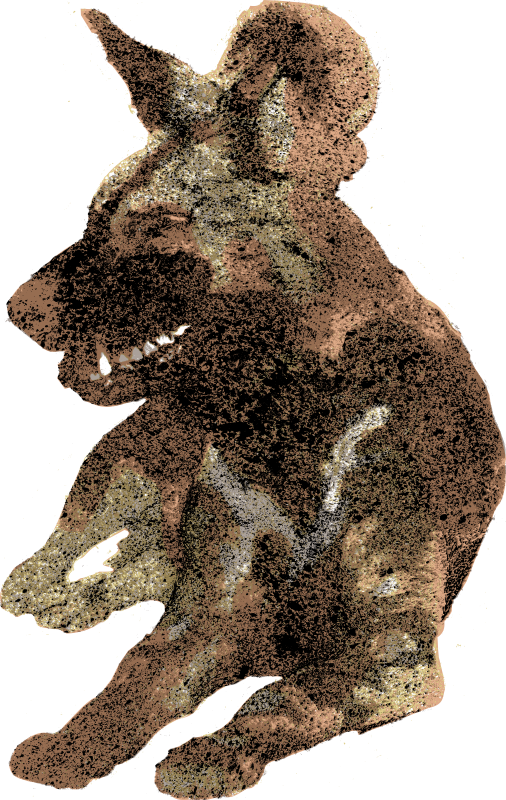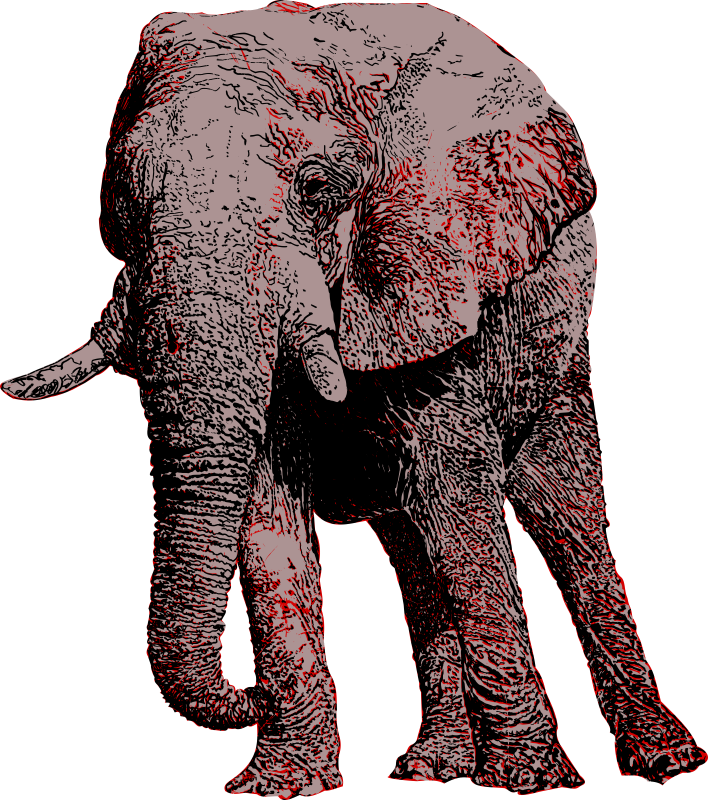Dear Reader, in this age of AI created content, please support with your goodwill someone who works harder to provide the human-made. Sign up at the top of the lefthand column or bottom of this page. You will receive my hand illustrated monthly newsletter RESTORE NATURE and access to the biodiversity garden design course as I write...and nothing else, I respect your time. I am also removing the advertizing as best I can as its become intrusive inappropriate and pays me nothing.
African animals
and nature conservation
 One of the endangered African animals whose protection depends on complex forces.
One of the endangered African animals whose protection depends on complex forces.Please support our writing and screen print design ! Buy one of our African animal designs of lions, leopards, baby animals, endangered animals and more:
Humans and the spectrum of conservation strategies for
African animals
The story of the conservation of large animals and apex predators in Africa shows that alienating humans from so called nature, or nature from us does not bode well for attempts at conserving nature and preserving biodiversity. When we ignore that humans and their particular needs and abilities form a part of the greater ecosystem the result is often competition and domination rather than collaboration between our species and the rest.
 A pen drawing of a buffalo which is used for a screen print positive
A pen drawing of a buffalo which is used for a screen print positiveReviewing literature on conservation in Africa shows very diverse approaches to the issue. Indeed as its been claimed, a different strategy is really needed for each species. There are a wide range of conservation approaches being applied worldwide. There is international work that is done trying to stem trade in the products of illegal hunting. This ranges from debunking myths about the properties of ivory and rhino horn, on other continents, in other words reducing demand in the market, to policing of ports and trade routes. There is local work which ranges from increasing technology and the militarization of conservation on the one hand to social approaches integrating local communities and giving them responsibility for the protection of their local game on the other. Treatment of poachers ranges from shooting them on sight to their inclusion in conservation as experts on the local animals. Treatment of the issue of hunting ranges from total bans to using trophy hunting to fund conservation. The efforts of various countries range from sad to very inspirational. There is great loss but also great human ingenuity and successful rehabilitation of game populations and ecosystems.
We will take a short look at some of the different rationales and strategies, starting with the greater use of policing and surveillance and then discussing a strategy of collaboration with local communities that includes the human ecosystem in the natural ecosystem. Ultimately it seems it is the local people who determine the outcomes. They are either seen as the problem or the solution, but there is no strategy which can afford to ignore them.
 African animals are social beings. 3 color Zebra mother and child
African animals are social beings. 3 color Zebra mother and childPolicing and seeing people as the problem
A famous wildlife protection organization operating in Africa, the AWF or African Wildlife Foundation, was founded way back in 1961, so it represents six decades of accumulated experience. They have a multi faceted approach, and their aim is to stop the killing of animals and the illegal trade in animal products. They work towards this by increasing wildlife authorities' anti poaching capacity. They provide equipment and training in the use of helicopters and drones, and help with law enforcement to ensure poachers do not escape punishment once arrested. They provide sniffer dogs at major ports on the east African coast, and run awareness programs in China and Vietnam debunking the beliefs that increase the demand for ivory and rhino horn. I would assume that after sixty years of experience they have found that more policing works.
To find another strategy one would have to look at the reasons for illegal activity in game reserves. According to a review and critique of conservation writing, the most frequently offered cause, poverty, is a simplistic explanation for illegal activity in conservancies.
A view which would probably be cast as typical of conservation literature is that of an article on tropical Africa written in 2014. I find it is informative on broad issues nonetheless. It is a survey of 105 protected areas (PA's) in tropical Africa, from the Gambia in the west all the way through in an almost continuous belt to Uganda in the east. The problems that are encountered could be found anywhere where there is a threat to conservation. Population pressure around reserves leading to habitat destruction, over exploitation of its resources, unsustainable hunting, logging, disease, fire, fuel collection, infrastructure building, mining, agriculture, armed conflict and human settlements inside or within 50 km of the PA are seen as the main threats, as are fragmentation of natural areas and isolation of species, which does not bode well for genetic diversity. Logging, farming and hunting are the greatest threats. All of these factors impact to a much greater degree, large animals that reproduce slowly. Many of these are key species for the survival of the whole ecosystem in terms of seed dispersion and their disappearance will bring an extinction cascade and compromise the ecosystem functions.
Many PA's are such on paper only, inadequately funded, suffer from a lack of government backing and rely on inadequate donor funding. This leads to a deficit of training and equipment. Decline in numbers and diversity persists, but positive effects are noticed where there is a presence of conservation NGO's, law enforcement, tourism or research. However there is very little data on conservation in Africa and outcomes.
So here we see an assessment where the presence of humans within 50 km of the PA is seen as a major problem, and where lack of government support, poor funding, and unsustainable exploitation of the PA are leading to its degradation.
 The painted wolf, found all over Africa less than a hundred years ago, and featured in Egyptian murals, is now endangered.
The painted wolf, found all over Africa less than a hundred years ago, and featured in Egyptian murals, is now endangered.People as the solution:
The case of Namibia
Seeing humans as a problem, to be kept out of conservancies, contrasts diametrically with the approach of Namibia. The first African nation to have conservation written into the constitution, there are claims that it is the only African country where African animals are increasing in numbers. After being decimated in the war in the 1980's the population of lions, leopards, cheetahs and antelope is recovering. This may be because they have done things differently.
The colonial regimes reserved the hunting of African animals for Europeans and criminalized indigenous hunting practice. Then the protected areas were estranged from the rural people as human habitation was just seen to be a threat to the reserves. Subsequent governments have inherited this situation which pits the government enforcers against villagers. The Namibian government gave the care of wildlife back to the people and NASCO and CBNRM Namibian association of community based natural resource management were founded, with strong government support. Former poachers were employed as guards and trackers, protectors of 'their' African animals. In a partnership of government, community and private sector, communities could build wildlife conservancies and profit from the proceeds. To date 79 have been established and the numbers continue to grow as does tourism revenue. Forty percent of Namibia's land area is now protected. The governement and NGO's such as WWF support training, grants, give technical assistance and offer practical solutions in wildlife management s well as ways to reduce the conflict and competition between humans and animals such as techniques for living in an area with wild African animals without having to resort to their destruction to protect crops, buildings and human life. Save the Rhino trust, Cheetah conservation fund, Namibian Dolphin project, the desert lion project and the Africat foundation.are other international NGO's that work with the conservancies and Namibian government. Some of the conservancies are so successful they no longer need aid or government support. This turnaround happened in just two decades. Illegal poachers are no longer welcome. Locals claim that conservancies are key to Namibia's success and leadership position in African conservation. They are now teaching other countries in Africa how to do this, like Zambia and Mozambique, and around the world like Mongolia and Nepal.
 The largest of the African animals, the African elephant.
The largest of the African animals, the African elephant.A social critique of writing on conservation in Africa
I return to the review of studies on conservation in Africa. They claim that too little interest is given to the motivations for poaching, and poverty is a simplistic explanation. Poverty seen merely as material deprivation is also at fault. Illegal hunting can be driven by high demand in distant countries. A history of the criminalization of indigenous hunting also leads to alienation from the desire for conservation of African animals. The article calls these structural factors. That is history, global inequities and global markets. They claim other drivers than poverty play a role on the personal level. Food insecurity is often not a driver of hunting. Poverty goes with a lack of power, prestige and voice and they claim this can be driver of illegal hunting, in the search for prestige, identity and affirmation. Enforcement and exclusion polarize conservation and local communities. Trust and legitimacy between protection staff and local people is key in compliance. But the UN secretary claims a more militarized approach is needed. In Malawi, enforcement personnel trained by South African private militia were implicated in 300 deaths, 325 disappeareances, 259 rapes, and torture between 1998 and 2000.
Positive incentives, such as creating economic links like tourism income are purely economical and assume market forces will protect the environment. They also take fore granted the agency of the individual, the ability to make choices, and sometimes poverty does not allow the space for much agency.
They claim the positive incentives approach has failed in sub Saharan Africa (ignoring the example of Namibia it seems) because most protected areas do not produce sufficient income to offset the cost of maintenance, and if they do, benefits are unevenly distributed.
Structural explanations question individual choice and incentives and encourage addressing root causes like the historic eviction to create protected areas, and emphasize wider rural development strategies. Only justice in social, political and economic relations can end the inequities which perpetuate poaching. Enforcement alone just shifts the problem to outside the reserve.
Conservation should focus less on legality and more on history. They recommend qualitative ethnographic work with illegal hunters.
Claims in support of trophy hunting
Trophy hunting is seen by many people as repulsive and barbaric, and does not respect the rights of animals. Others claim it is the biggest single money bringer supporting conservation. Both may be true and its a difficult issue.
Whether it is appropriate or not, an article claims that when Kenya terminated all hunting in the 1970's it lost 85% of its wildlife. In contrast, hunting tourism in South Africa is claimed as an unparalleled success story for saving African animals. Wildlife tourism earned the country ten billion in 2014, and trophy hunting (locally referred to with derision as 'canned lions') sustains so many game reserves that with 10 thousand private game ranches on 21 million hectares there is three times more protected area under private game management in South Africa than government owned. The land under wild life increased since 1964 and the game went from half a million to twenty four million. Many key species are mostly found on private land.
 Zebra and many other African animals are increasing again in Namibia.
Zebra and many other African animals are increasing again in Namibia.Large animals are only part of the ecosystem in which they flourish
Drives for the conservation of large African
animals should not stand alone. It is a vastly complex issue, but
the large animals are the tip of the food chain and are supported by
a myriad of others life forms which sustain them, from microbes to insects and
plants. Large herbivores and predators keeping them moving change the landscape for the better, enriching soil and sequestering carbon. This is a pattern which regenerative agriculture attempts to imitate with electric fencing and moving herds of cattle. Should the world not preserve this wonderful counter to the degradation of soil, accumulation of atmospheric carbon and the consequent global warming that is still self maintaining in some areas of Africa, and brings tourism revenue to people who need it ?
The basis of the ecosystem may be vegetation, or even more basically, healthy soil, but the part of the ecosystem with the most impact is one which is conceptually and erroneously not considered a part of nature at all. Most importantly, human beings are part of the mix and as is shown by the Namibian example, when its done right, they are the solution.
------
home page with links to hundreds of ecological gardening articles
------
Restore Nature Newsletter
I've been writing for four years now and I would love to hear from you
Please let me know if you have any questions, comments or stories to share on gardening, permaculture, regenerative agriculture, food forests, natural gardening, do nothing gardening, observations about pests and diseases, foraging, dealing with and using weeds constructively, composting and going offgrid.
SEARCH
Order the Kindle E-book for the SPECIAL PRICE of only
Prices valid till 30.09.2023
Recent Articles
-
garden for life is a blog about saving the earth one garden at a time
Apr 18, 25 01:18 PM
The garden for life blog has short articles on gardening for biodiversity with native plants and regenerating soil for climate amelioration and nutritious food -
Cape Flats Sand Fynbos, Cape Town's most endangered native vegetation!
Apr 18, 25 10:36 AM
Cape Flats Sand Fynbos, a vegetation type found in the super diverse Cape Fynbos region is threatened by Cape Town's urban development and invasive alien plants -
Geography Research Task
Jan 31, 25 11:37 PM
To whom it may concern My name is Tanyaradzwa Madziwa and I am a matric student at Springfield Convent School. As part of our geography syllabus for this
"How to start a profitable worm business on a shoestring budget
Order a printed copy from "Amazon" at the SPECIAL PRICE of only
or a digital version from the "Kindle" store at the SPECIAL PRICE of only
Prices valid till 30.09.2023







